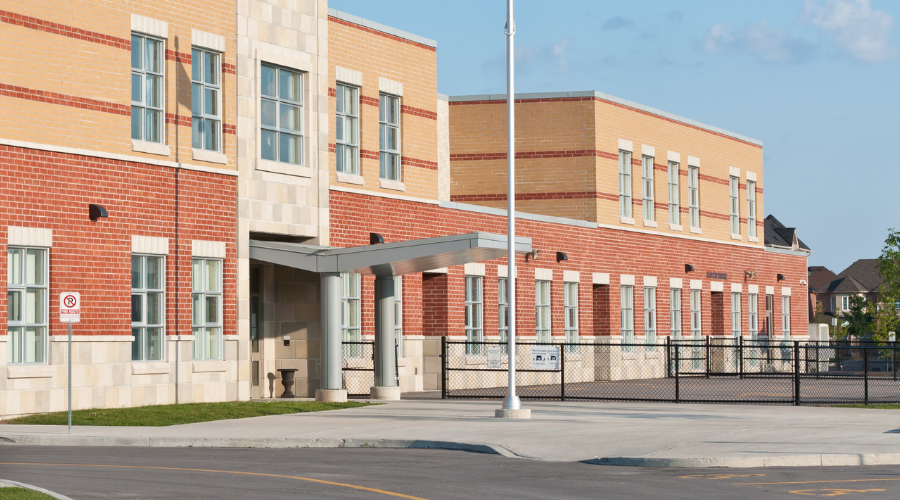Video Surveillance & Content Analytics Improve Safety in K-12 Schools

Video surveillance networks alone don’t solve all security challenges
Video surveillance (CCTV) systems have been common in public school systems for more than 20 years, playing a crucial role in physical security. Such camera networks are essential for real-time monitoring of buildings, playgrounds, parking lots, and athletic fields, to as well as visitors, staff and students, and for identifying potential threats, such as a stranger on campus or a crowd forming. Video surveillance cameras provide key forensic video evidence of incidents such as fights, vandalism, or vehicle accidents on campus. Cameras are an investigative tool, but they can also be leveraged to prevent incidents: the presence of video cameras is thought to discourage bad behavior such as cheating on exams, vandalism, or fighting. Classroom surveillance is less common, but some districts have even implemented it for the sake of investigating accusations of abuse. CCTV networks are powerful tools, but they alone can’t solve all school security challenges.
The evolution of video cameras and technology
Over the decades, camera networks and the technology that supports them have evolved dramatically. Many, if not most, school video cameras are connected to the Internet, which enables authorized operators to log into a browser-based dashboard, so they can monitor live feeds from off-campus, after hours, or during long school breaks, such as vacation periods. There are also thermal imaging cameras that can detect activity in dark areas, such as an athletic field, where traditional cameras may be less effective due to low light conditions.
Given the prevalence of cameras, there is no shortage of video feeds to monitor or footage to review. In fact, most school security teams don’t have the staff resources to constantly, effectively monitor all the video feeds, nor do they have a lot of time to devote to reviewing post-incident footage. Schools need two things: 1) an automated system that can detect real-time abnormalities or anomalies in a camera view, and 2) an effective way to review video footage. Video content analytics software offers a solution to these challenges and other requirements.
What is video intelligence software?
Powered by Artificial Intelligence and Deep Learning, video intelligence software extracts, classifies, indexes, and recognizes objects and behaviors that are captured on video. This makes it possible to search and review footage quickly and accurately, using multiple filters based on based on object class and attributes such as clothing or vehicle type and color, direction of movement, gender, or an adult vs. child. In addition, such software collects and aggregates long-term video data, which helps school administrators derive operational intelligence reports, such as heatmaps that illustrate footfall in buildings and across campus or dashboards that show vehicle or pedestrian traffic volume. This long-term data identifies patterns, to help school administrators improve school scheduling, traffic patterns, or campus layout.
Improve situational awareness and response time
Because video analytics software aggregates data over time, system operators can analyze and benchmark what is normal in terms of behavior, objects, and activity. The system can then be configured to detect when those benchmarks or norms have been exceeded, which enables operators to create custom alerts for when thresholds have been exceeded or anomalies occur. Those custom alerts empower administrators and security teams to improve their awareness of situations as they unfold, and proactively respond. For example, if a crowd of students gathers in a hallway, exceeding the custom threshold, that may indicate a disturbance, in which case the system would automatically send a people-count alert for an operator to assess. Similarly, video intelligence software line crossing alerts can track of the number of people in high school auditorium or gymnasium to ensure compliance with building occupancy codes. Or, if the lights are normally off in an office or a classroom during particular hours, the analytics system can detect and notify operators if the lights are on during off-hours. If students or visitors are dwelling for an exceptionally long time in a certain area, that may indicate suspicious behavior, or a potential medical emergency; the system can send a dwell alert to security staff so they can assess the situation.
Accelerate forensic review of footage
School security teams must investigate a variety of behavioral, criminal, or medical incidents. Manual forensic review of video footage is time-consuming, and subject to human error or oversight. In contrast, the sophisticated filtered search functions of video intelligence software enable investigators to sift through high volumes of video footage, from multiple cameras, in a matter of minutes or hours instead of days, thus saving investigators time to resolve an incident and reduce time to target. And, it is more accurate, allowing investigators to find a person of interest with pinpoint precision.
Face recognition, appearance similarity, and license plate recognition tools
Investigators can also search for persons or vehicles of interest by using appearance similarity, face recognition or license plate recognition functions. Operators can also use video analytics to customize real-time alerts, in which the system can detect a face or a license plate number that matches an image on a digital watchlist. For example, a digital watchlist could contain an image of a missing child, a whole or partial license plate of a particular vehicle, or the faces of known local sex offenders. These real-time alerts can help security officers quickly locate a vehicle or person of interest on campus.
Video cameras in K-12 schools are producing large volumes of footage; it is time to tap that video data to uncover valuable information that can make security teams and administrators more effective and efficient. Video cameras have improved over the years, but they alone do not offer a magic solution to school security challenges. Rather than installing more cameras, or higher resolution cameras throughout a campus, schools can get more value from their existing video surveillance networks by coupling them with video content analytics software.
Signup to receive a monthly blog digest.